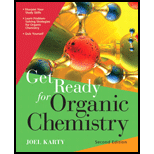
Concept explainers
Interpretation:
In Figure 26-14, new lines indicating two monomers linking together, indicating an existing
Concept introduction:
Step-growth
Want to see the full answer?
Check out a sample textbook solution
Chapter 26 Solutions
Get Ready for Organic Chemistry
- For the following polymer partial structure, draw the appropriate vinyl monomer.arrow_forwardAlanine, shown below, is an example of a(n) [aromatic, basic, acidic, polar, or non polar] amino acid and would most likely be found on the [inside or outside] of a proteinarrow_forwardDraw a segment of a polymer (containing three monomers) that forms from anionic polymerization of the compound shown below.arrow_forward
- Draw the monomer unit(s) from which the following polymer is made. to • In the case of a reactive acyl monomer, draw a methyl ester. • Draw one structure per sketcher. Add additional sketchers using the drop-down menu in the bottom right corner. • Separate structures with + signs from the drop-down menu. opy astearrow_forwardWhat small molecule is generated during the polymerization in the above molecule?arrow_forward5. If you take a chemically recyclable polymer and break it down to a monomer. How do you determine if the new polymer from the monomer is the same as the first one? Please give three technique for explanation.arrow_forward
- A Twaron polymer strand is hydrolysed. Question: State the conditions that could be used to hydrolyse the polymer.arrow_forwardBelow is the tabulated molecular weight data for a polytetrafluoroethylene [-(C₂F4)-]n material. Compute for (a) the number-average molecular weight, (b) the weight- average molecular weight, and (c) the degree of polymerization. Atomic weight data: Carbon (12.01 g/mol); Fluorine (18.998 g/mol). Copy the table on your examination paper and include tabulated data of Xi, Wi, Mi, MiXi and MiWi Molecular Weight Range (g/mol) 10,000 - 20,000 20,000-30,000 30,000 - 40,000 40,000 - 50,000 50,000 - 60,000 60,000 - 70,000 70,000 - 80,000 80,000-90,000 Mass, g 0.5 2.0 5.5 11.5 12.0 9.0 6.0 3.5 Length, cm 1.5 4.5 7.5 12.5 11.0 7.0 4.0 2.0arrow_forwardProvide an explanation.arrow_forward
- Draw the structure of the polymer which would form when the following molecules react. (draw two unitsarrow_forwarda) What is the difference between high- and low-density classifications of polyethylene? b) Among the 6 polymer resins, identify which can be recycled. Explain why we can't recycle the other types.arrow_forwardList down the factors that affect the cationic polymerization.arrow_forward
- Chemistry: Matter and ChangeChemistryISBN:9780078746376Author:Dinah Zike, Laurel Dingrando, Nicholas Hainen, Cheryl WistromPublisher:Glencoe/McGraw-Hill School Pub Co
 Organic ChemistryChemistryISBN:9781305580350Author:William H. Brown, Brent L. Iverson, Eric Anslyn, Christopher S. FootePublisher:Cengage Learning
Organic ChemistryChemistryISBN:9781305580350Author:William H. Brown, Brent L. Iverson, Eric Anslyn, Christopher S. FootePublisher:Cengage Learning

